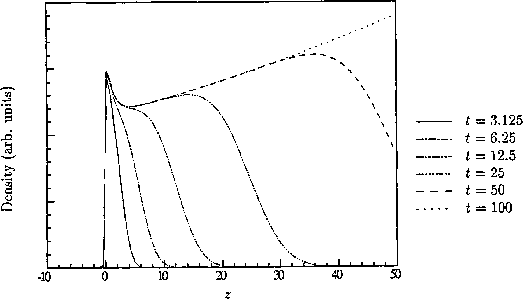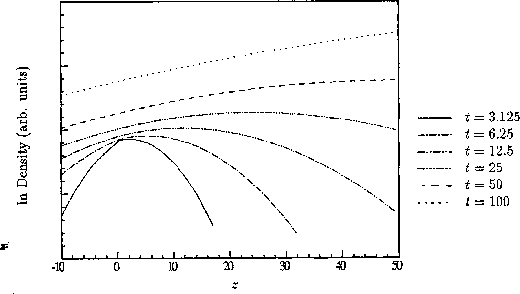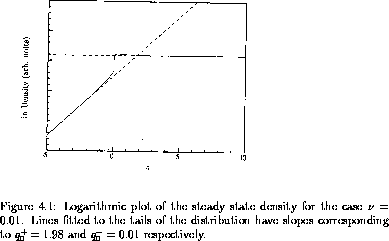




Next: Asymptotic behaviour for
Up: Non-hydrodynamic effects in
Previous: Conventional Theories
We numerically computed the number density  as a function of z, and the reaction rate
as a function of z, and the reaction rate  .
In these computations charged particles are injected
at a constant rate into the
drift region with velocity equal to the drift velocity, a,
which is set to unity.
The computations were carried out using the exact form of the Greens
function (
.
In these computations charged particles are injected
at a constant rate into the
drift region with velocity equal to the drift velocity, a,
which is set to unity.
The computations were carried out using the exact form of the Greens
function ( ).
).
The phase space distribution may be found by integrating the Greens
function over source times  :
:

Firstly the integration over c to find the number density was performed
analytically, and then the time integration was performed numerically
using an adaptive integrator. Plates 1 to 3 show  at
times t=6, t=25, and t=100 respectively, for the
reactionless case
at
times t=6, t=25, and t=100 respectively, for the
reactionless case  .
.
Figures  to
to  show the effect of varying the reaction rate
show the effect of varying the reaction rate  .
In the cases
where
.
In the cases
where  , the distribution builds up to a steady state
distribution. Non-hydrodynamic effects manifest themselves in a
neighbourhood of size
, the distribution builds up to a steady state
distribution. Non-hydrodynamic effects manifest themselves in a
neighbourhood of size  (= 1.374, 1.366 and 0.995 for
(= 1.374, 1.366 and 0.995 for  =
=  , 0 and 0.01) around the origin. Outside this
region, the non-hydrodynamic modes (
, 0 and 0.01) around the origin. Outside this
region, the non-hydrodynamic modes ( ) are damped exponentially
with respect to the hydrodynamic mode (n=0), and it is here that we see
exponential behaviour governed by the Townsend ionization coefficient. In
figures
) are damped exponentially
with respect to the hydrodynamic mode (n=0), and it is here that we see
exponential behaviour governed by the Townsend ionization coefficient. In
figures  and
and  , the steady state distribution
is plotted on a logarithmic
plot. It can be seen that the density behaves exponentially in z far from
the source. The slopes at either extremity give
, the steady state distribution
is plotted on a logarithmic
plot. It can be seen that the density behaves exponentially in z far from
the source. The slopes at either extremity give  downstream of
the source, and
downstream of
the source, and  upstream. This is evidence that the positive
branch roots control the spatial decay of particles diffusing against the
electric field.
upstream. This is evidence that the positive
branch roots control the spatial decay of particles diffusing against the
electric field.

Figure:
Density for  . In the following four figures
the curves shown are at
successively greater times after the source is switched on.
. In the following four figures
the curves shown are at
successively greater times after the source is switched on.

Figure:
Density for  .
.

Figure:
Density for  .
.

Figure:
ln Density for  .
.

Figure:
Logarithmic plot of the steady state density for the
case  . Lines fitted to the tails of the distribution have slopes
corresponding to
. Lines fitted to the tails of the distribution have slopes
corresponding to  and
and  respectively.
respectively.

In figure  , the reaction rate has been increased
to larger than
, the reaction rate has been increased
to larger than  . In this
case, no steady state is seen to occur. Rather, the density of charged
particles increases exponentially in time. Physically this can be
understood as the electric field not being strong enough to remove at a
sufficiently rapid rate the
charged particles created by ionization. This effect will be seen to arise
out of the analysis in the next section.
. In this
case, no steady state is seen to occur. Rather, the density of charged
particles increases exponentially in time. Physically this can be
understood as the electric field not being strong enough to remove at a
sufficiently rapid rate the
charged particles created by ionization. This effect will be seen to arise
out of the analysis in the next section.





Next: Asymptotic behaviour for
Up: Non-hydrodynamic effects in
Previous: Conventional Theories
Russell Standish
Thu May 18 11:43:52 EST 1995
 as a function of z, and the reaction rate
as a function of z, and the reaction rate  .
In these computations charged particles are injected
at a constant rate into the
drift region with velocity equal to the drift velocity, a,
which is set to unity.
The computations were carried out using the exact form of the Greens
function (
.
In these computations charged particles are injected
at a constant rate into the
drift region with velocity equal to the drift velocity, a,
which is set to unity.
The computations were carried out using the exact form of the Greens
function ( :
:

 at
times t=6, t=25, and t=100 respectively, for the
reactionless case
at
times t=6, t=25, and t=100 respectively, for the
reactionless case  .
.
 .
In the cases
where
.
In the cases
where  , the distribution builds up to a steady state
distribution. Non-hydrodynamic effects manifest themselves in a
, the distribution builds up to a steady state
distribution. Non-hydrodynamic effects manifest themselves in a
 (= 1.374, 1.366 and 0.995 for
(= 1.374, 1.366 and 0.995 for  =
=  , 0 and 0.01) around the origin. Outside this
region, the non-hydrodynamic modes (
, 0 and 0.01) around the origin. Outside this
region, the non-hydrodynamic modes ( ) are damped exponentially
with respect to the hydrodynamic mode (n=0), and it is here that we see
exponential behaviour governed by the Townsend ionization coefficient. In
figures
) are damped exponentially
with respect to the hydrodynamic mode (n=0), and it is here that we see
exponential behaviour governed by the Townsend ionization coefficient. In
figures  downstream of
the source, and
downstream of
the source, and  upstream. This is evidence that the positive
branch roots control the spatial decay of particles diffusing against the
electric field.
upstream. This is evidence that the positive
branch roots control the spatial decay of particles diffusing against the
electric field.

 . In the following four figures
the curves shown are at
successively greater times after the source is switched on.
. In the following four figures
the curves shown are at
successively greater times after the source is switched on.

 .
.

 .
.

 .
.

 . Lines fitted to the tails of the distribution have slopes
corresponding to
. Lines fitted to the tails of the distribution have slopes
corresponding to  and
and  respectively.
respectively.

 . In this
case, no steady state is seen to occur. Rather, the density of charged
particles increases exponentially in time. Physically this can be
understood as the electric field not being strong enough to remove at a
sufficiently rapid rate the
charged particles created by ionization. This effect will be seen to arise
out of the analysis in the next section.
. In this
case, no steady state is seen to occur. Rather, the density of charged
particles increases exponentially in time. Physically this can be
understood as the electric field not being strong enough to remove at a
sufficiently rapid rate the
charged particles created by ionization. This effect will be seen to arise
out of the analysis in the next section.